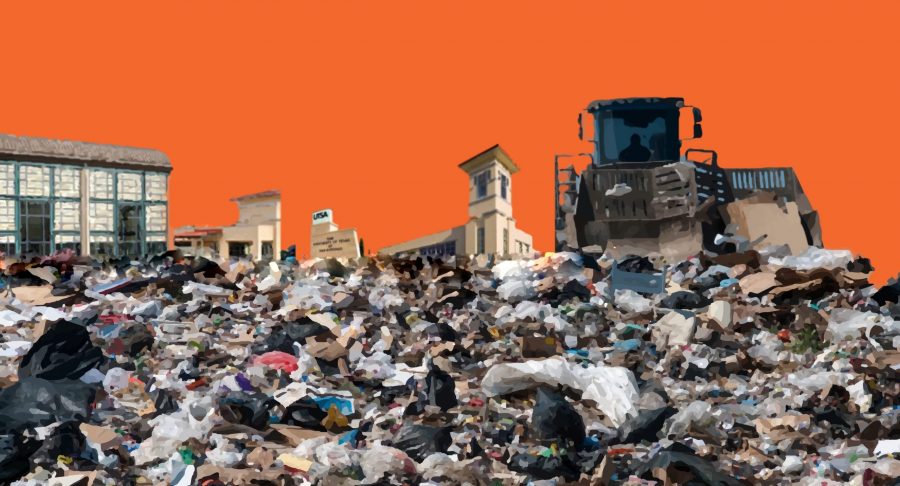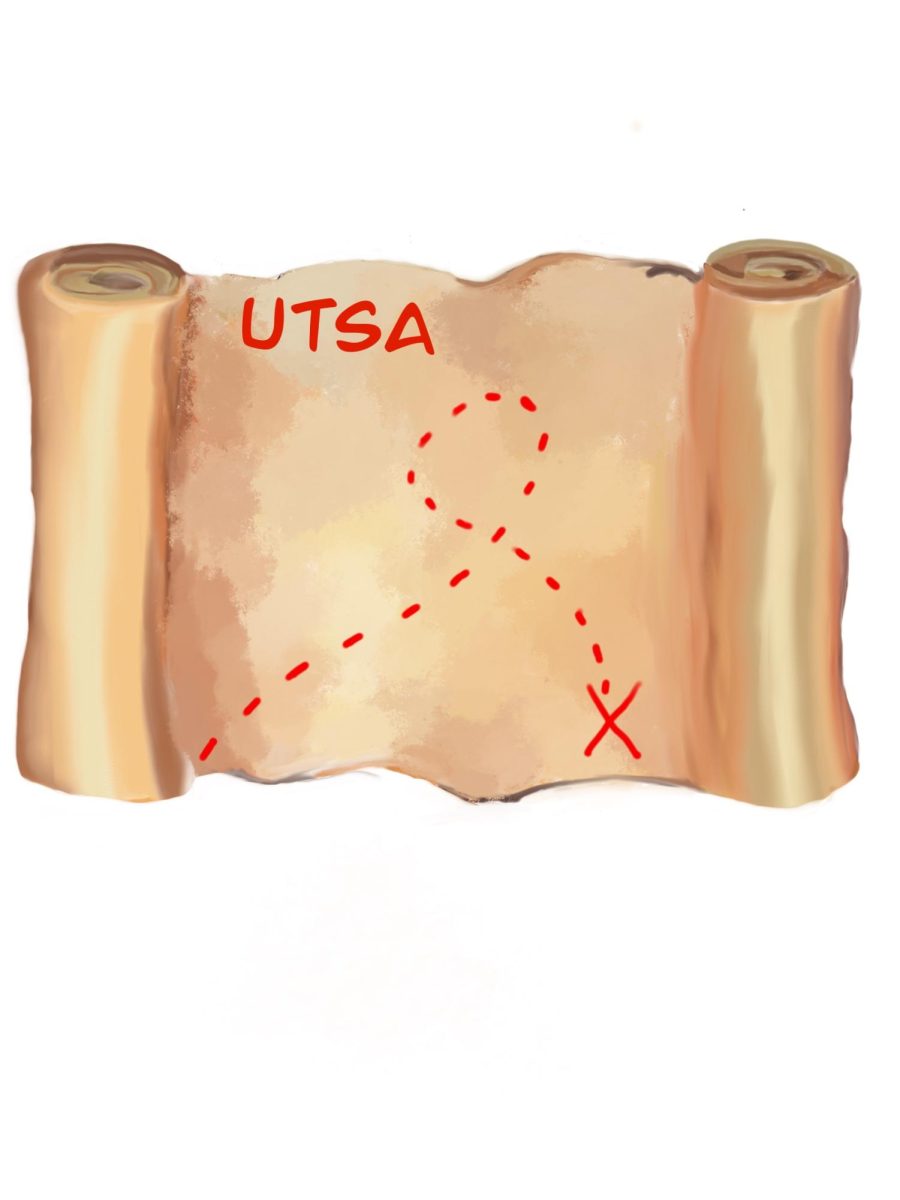A glance at our growing city’s waste management situation.
Mountains of rubbish. Toxic chemicals in the air. Doubtful signs of sustainable life. When asked about the way people dispose of waste on campus, one UTSA Biochemistry student, Liz Cervantes said, “When I see people not recycling, I want to scream ‘have you not seen WALL-E!”
The 2008 film WALL-E, was set in two locations: One showing a dystopian future of what may happen to the Earth if humans do not sustain and care for the Earth’s future; the other set on a spaceship where those wealthy enough can escape the Earth.
Though WALL-E depicts a fictional tale, it resonates with warnings about our potential future.
The direction of our future quality of life is typically spearheaded locally. Regarding San Antonio, UTSA professor of U.S. history Lesli Hicks, recalls the local National Public Radio affiliate stating 147 people are moving to the city every day.
In fact, U.S. Census data indicates that Texas continues to be one of the fastest growing states in the country and has been for the last three decades. Hicks explained she could ‘feel’ the change in comparison to when she first moved here in 1971, when the population consisted of roughly 300,000 people. “Traffic is intense… lines at H-E-B and Walmart–and everywhere are longer than they used to be.”
Given that 1.1 million more people will live in the San Antonio area by 2040, it is clear that “business as usual” cannot be continued. This growth represents a tremendous opportunity for the San Antonio metropolitan region but could undermine our quality of life if we do not plan and act appropriately, specifically speaking to the growth and development of the population’s effect on waste management.
San Antonio’s population as of 2016 clocks in at 1.493 million. Considering the U.S. Environmental Protection Agency’s (EPA) calculations that on average, Americans recycle and compost 1.51 pounds of the individual waste generation of 4.40 pounds per person per day, the question begs to be asked: Where does all of that waste go? Moreover, how are we managing it?
The City’s Solid Waste Management Department (SWMD) developed a Recycling and Resource Recovery Plan that outlines a vision for zero waste. It offers strategies and actions to improve waste reduction and recycling programs through education, outreach, incentives and regulatory changes.
According to SWMD, the average single-family household in San Antonio generates about eight pounds of waste every day.
Fortunately, despite population growth, recycling rates have increased and consumers are now sending less waste to landfills. After instituting automated recycling services and other improvements to make recycling more convenient for residents, household recycling increased almost four-fold. According to an SA-Tomorrow report, 29 percent of the residential waste stream was being recycled by 2014. The City’s goal is to increase the singlefamily residential recycling rate to 60 percent by 2025. Since the adoption of the Recycling and Resource Recovery Plan in 2010, annual landfill waste has seen an 18 percent reduction, from 444,000 tons to 362,000 tons.
To move closer to fulfilling its zero waste vision, the city can establish regulations to minimize waste generation through effective waste reduction, reuse and recycling. City residents are also encouraged to take the lead by prioritizing the use of as many recycled materials as possible for all city facilities and programs.
Waste management begins with the individual. If a student buys a cup of coffee before a morning class every day of the week during the school year, that is roughly 160 paper cups, plastic lids and paper sweetener packets or stir straws that contribute to annual waste production.
At UTSA, the Office of Environmental Health, Safety and Risk Management oversees the daily collection of waste and recycling on UTSA campuses. Recycling and waste minimization efforts do not just save money, they contribute to a sustainable environment and a greener campus. The goal is to improve recycling efforts, aided by UTSA’s adoption of a single-stream recycling process to decrease waste and increase recycling. In this process, all recyclable items are placed in a single container and are sorted off-site at a recycling facility. Streamline is similar to the recycling program implemented by the City of San Antonio. In recent years, the UTSA community has recycled hundreds of tons of mixed paper and cardboard, electronics, lamps, batteries, glass, metal, plastic and other materials.

The UTSA campus provides recycling containers for all faculty, staff and students at the University housing. Indoor and outdoor receptacles are located throughout campus, offering a convenient way for everyone to do their part.
UTSA is also competing in Recyclemania 2018, the nationwide intercollegiate contest. This friendly annual competition, which runs this year from Jan. 21 to Mar. 31, is a way to help our community become better stewards for our environment.
Students, faculty and staff can quickly contribute by thinking of recyclable products for disposal in the blue recycling containers. Schools that recycle the most per capita win the competition. Here are recycle Do’s and Don’ts at UTSA:
As UTSA Texas Politics and Society Professor Henry Esparza says, “awareness and education go hand in hand.”The successful ad campaign “Don’t Mess with Texas” speaks to this, but it can only go so far. Texas has punitive laws to try and dissuade citizens from littering. “Land is finite,” Esparza continues, “communities do not want to deal with waste dumps in their backyard. We remember NIMBY (Not In My Backyard) when communities fought to keep unsightly waste dumps from their neighborhoods. As neighborhoods get more and more congested, the pressure for us all will be paramount. Passing a waste law to future generations or just passing the burden will not work!”
The city of San Antonio waste management website and core mission is as follows: “Protect the public health and safety of the City of San Antonio by providing quality municipal solid waste services and environmental programs that are safe, efficient, cost-effective and environmentally responsible.”
Esparza suggests the UTSA community must adopt the same core mission and make it part of freshman orientation and allow those vested to speak to students about the importance of environmental waste management.
If we are not good stewards for our environment by efficiently managing waste now, we will pay for it heavily in the future. The environment will continue its trend of a downward spiral if individuals do not act now. San Antonio is taking steps in the right direction, but San Antonio is you, it is me, it is your neighbors. Think about what bin your waste goes in before tossing it.












